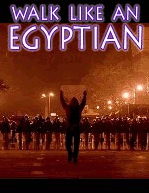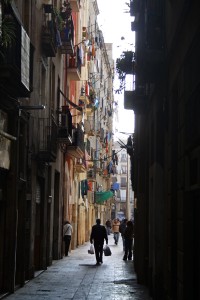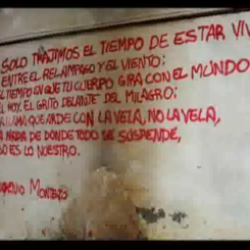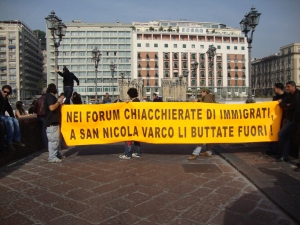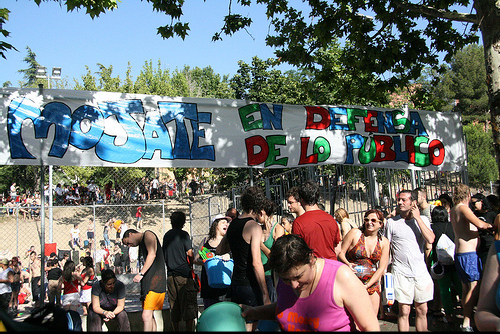 2011 will be the 30th year in which
2011 will be the 30th year in which, in the outskirts of Madrid, and despite the ban of the City Council, the
Naval Battle of Vallekas will take place: a popular and politically engaged
fiesta that celebrates the independence of the neighborhood and its
the proclamation of Vallecas as a seaport. Anthropologist
Elizabeth Lorenzi, got involved in the neighborhood since 1998, and recently published an
ehtnography of the fiesta (downloadable for free in PDF) in which, beginning from the Naval Battle,
she analizes the urban and social transformations of Vallecas in the last decades, the role played in it by the grassroot movements, and the consequences of all this in the building and maintanance of the neighborhood identity. The Naval Battle celebrates and strenghtens the
vallekanismo: the neighborhood as a frame for social mobilizations. Through this symbolic device, the long history of political demands, neighbors' struggles, anarchist movements of Vallecas, become part of the process of constructing the neighborhood identity.

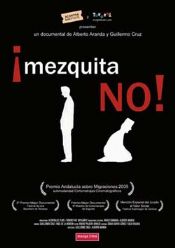 Six cities around Barcelona - Hospitalet, Badalona, Terrassa, Sabadell, Mataró, Santa Coloma de Gramenet - are among the ten most populated in Catalonia. But only Hospitalet and Santa Coloma have a higher density than Barcelona, compact city par excellence. The urbanistic chaos that characterises Santa Coloma de Gramanet is the direct result of real estate speculation and political corruption: persistent racism among some sectors of its population is the other side of overcrowding and impressive diversity of origins that defines the people of Santako. But if in the beginning of the 20th century, those who rejected the immigrants from southern Spain settled in the casas baratas at least could hold to their local origins and catalan speech, in the 21th century those who promote boycott to arabics, chinese, latinamericans, romans of the city, are themselves - for the most part - second generation immigrants. The video Mézquita no! (2005) describes the conflict around the opening of a mosque in the Singuerlin neighborhood.
Six cities around Barcelona - Hospitalet, Badalona, Terrassa, Sabadell, Mataró, Santa Coloma de Gramenet - are among the ten most populated in Catalonia. But only Hospitalet and Santa Coloma have a higher density than Barcelona, compact city par excellence. The urbanistic chaos that characterises Santa Coloma de Gramanet is the direct result of real estate speculation and political corruption: persistent racism among some sectors of its population is the other side of overcrowding and impressive diversity of origins that defines the people of Santako. But if in the beginning of the 20th century, those who rejected the immigrants from southern Spain settled in the casas baratas at least could hold to their local origins and catalan speech, in the 21th century those who promote boycott to arabics, chinese, latinamericans, romans of the city, are themselves - for the most part - second generation immigrants. The video Mézquita no! (2005) describes the conflict around the opening of a mosque in the Singuerlin neighborhood. 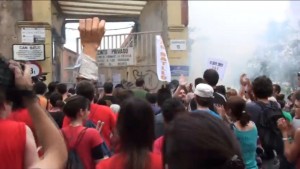
 2011 will be the 30th year in which, in the outskirts of Madrid, and despite the ban of the City Council, the Naval Battle of Vallekas will take place: a popular and politically engaged fiesta that celebrates the independence of the neighborhood and its the proclamation of Vallecas as a seaport. Anthropologist Elizabeth Lorenzi, got involved in the neighborhood since 1998, and recently published an
2011 will be the 30th year in which, in the outskirts of Madrid, and despite the ban of the City Council, the Naval Battle of Vallekas will take place: a popular and politically engaged fiesta that celebrates the independence of the neighborhood and its the proclamation of Vallecas as a seaport. Anthropologist Elizabeth Lorenzi, got involved in the neighborhood since 1998, and recently published an  The transformation of the center of Alcoy, the most ancient industrial city in Spain, between Valencia and Alicante, entails great demolitions in the Partidor neighborhood, cradle of the spanish working class movement. The City Council is buying the buildings of the neighborhood one by one, then
The transformation of the center of Alcoy, the most ancient industrial city in Spain, between Valencia and Alicante, entails great demolitions in the Partidor neighborhood, cradle of the spanish working class movement. The City Council is buying the buildings of the neighborhood one by one, then 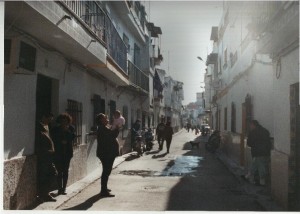 Just as in Barcelona, gentrification arrived to Seville in the eighties, when the city began to prepare for
Just as in Barcelona, gentrification arrived to Seville in the eighties, when the city began to prepare for 